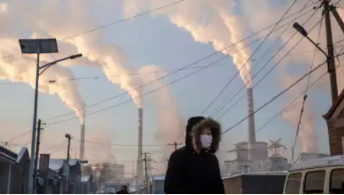Fra RBC:
Rising greenhouse gas (GHG) emissions are causing global temperatures to increase, which contributes to more extreme weather events and changing climate patterns.1 In order to reduce emissions, significant transformation is required across energy, food, transportation, and infrastructure systems. This will require investment in both “green” opportunities (e.g., renewable electricity, energy efficiency, and green buildings) and “transition” opportunities (e.g., energy companies in the process of decarbonizing, producers of critical minerals for batteries and solar panels, and low-carbon technologies for hard-to-abate sectors like steel and cement). At the same time, a focus on adaptation is needed to enable resilience in the face of a changing climate and more intense and frequent extreme weather events.
Governments have an important role to play in establishing effective policies and incentives to support a stable, orderly, and just transition to a net-zero economy. In 2015, with the signing of the Paris Agreement by 195 countries, governments committed to a shared ambition for global mitigation and adaptation. Five years after the signing of the Paris Agreement, we are at a pivotal moment for climate change. This year’s annual climate change conference will set the tone and direction of climate action for the decade to come.
What is COP26?
COP stands for Conference of the Parties, and it is an annual global United Nations summit about climate change and the actions countries are planning to take to address the needs of climate mitigation and adaptation. These summits are held annually and attended by countries that signed the United Nations Framework Convention on Climate Change (UNFCCC) – a treaty agreed to in 1994. After cancelling the 2020 COP due to Covid-19, the 2021 summit will be the 26th meeting, which is why it’s called COP26.
There are three components to a COP: the negotiations, exhibitions, and side events. COP26 will take place in Glasgow in November 2021.
Did you know?
The Paris Agreement was negotiated and agreed to at COP212 and included commitments by countries:
- to establish targets to reduce harmful greenhouse gas emissions by 2030 and to enable the energy transition;
- to limit global temperature increases to “well below” 2oC (3.6oF) and to aim to limit it to 1.5oC;
- to review progress made on the agreement every five years and submit progressively ambitious country climate commitments, called nationally determined contributions (NDCs); and
- to spend US$100 billion dollars a year (by 2020) in climate finance to help poorer countries, with a commitment to further finance in the future.
What should we expect at COP26?
Signatories to the Paris Agreement will participate in negotiations on a range of topics. The key priorities for COP26 are:
- To establish common timeframes for emissions-reduction targets. This will support comparable, consistent, and accountable national targets that are aligned with the latest science (see box below).This includes deciding whether country targets should be reviewed and set every five or ten years – the shorter timeframe could potentially drive greater accountability and ambition.
- To strengthen climate adaptation and focus on solutions that lessen the impacts of climate change. This will include discussions on the role of nature-based solutions; that is, how forests, ecosystems, and key sectors (e.g., agriculture) can support our ability to absorb, store, and sequester carbon.
- To enable transparent, effective, and high-quality carbon markets across jurisdictions. A key feature of the Paris Agreement is to allow countries to cooperate in meeting their commitments, via carbon emissions trading. Further clarity on the operation of market and non-market mechanisms for limiting GHG emissions remains to be developed.
- To agree on climate finance targets, which are critical for less developed countries that are more vulnerable to climate impacts. While the Paris Agreement set a target of US$100 billion by 2020, a new target for climate finance by 2025 is expected.
What makes COP26 different than other years?
- COP26 marks the fifth meeting since the signing of the Paris Agreement in 2015. The agreement officially came into force in 2016.
- Updated climate commitments come due this year (delayed from 2020 due to Covid-19). Signatories to the Paris Agreement are required to provide more ambitious targets (NDCs) for reducing GHG emissions every five years under a “ratchet mechanism.”
- It is the first time that the United States will participate in a COP since they confirmed their planned exit from the Paris Agreement in 2016. They announced their re-entry into the agreement in 2021.
- The Paris Agreement set 2020 as the year developed nations were due to deliver on the target of US$100 billion in climate financing. COP26 will present an opportunity to measure progress in meeting that target and discuss gaps.
- It is broadly viewed by climate scientists as a critical moment for achieving the global ambition of limiting warming to 1.5oC. According to the Intergovernmental Panel on Climate Change, global carbon emissions must decline by about 45% relative to 2010 levels by 2030 if we are to limit warming to 1.5o 3
- Extreme weather events are increasingly disrupting economies, supply chains, and communities, putting a laser focus on the need for climate adaptation and resilience in the face of a changing climate.
The latest climate science
In August 2021, the Intergovernmental Panel on Climate Change (IPCC) updated their 6th Assessment Report on the state of climate change – their previous report was published in 2014. The IPCC is a United Nations (U.N.) body of 195 member states that assesses the science related to climate change. The scientific bodies of every U.N. member country agree on the findings of the report, which will serve as the foundation of climate science for COP26. Here are some key takeaways from the report4:
- It is unequivocal that climate change is due to human activity. The past decade was hotter than any period in the last 125,000 years, and this increase is directly due to the increase in GHG emissions in the atmosphere.
- Global average temperatures will continue to rise until at least 2050 under all emissions scenarios. The assessment shows that Earth could well exceed the 1.5℃ warming limit by the early 2030s.
- Climate science has advanced considerably and is becoming more exact. Scientists can now directly link specific weather events to climate change and the type and range of climate data available has expanded considerably since the last report.
- There is still time to reduce emissions, but it will require new solutions and significant effort. If emissions continue on their current trajectory, the “carbon budget” will run out in 12 years. Significant transformation is required across the energy, food, transportation, and infrastructure systems. We will also need to use negative emissions technologies or nature-based solutions to remove emissions from the atmosphere.
As an asset manager and fiduciary of our clients’ assets, RBC Global Asset Management (GAM)5 has a duty to consider all material factors that may impact the risk-adjusted returns of our investments. Climate change is one such factor.
In April 2020, RBC GAM published our approach to climate change, which formalizes the commitments and actions we are taking to fully integrate climate change into our investment process. This includes the use of climate data and analytics to measure and assess the impact of climate risks and opportunities at an issuer and portfolio level. We also use climate scenario analysis to measure the potential financial impact of these risks and opportunities on our investments under different climate pathways, such as a 2oC or 1.5oC scenario. RBC GAM publicly supports the principles of the Paris Agreement and the international goal to hold global warming to well below 2oC. We will continue to advance global efforts to enable climate mitigation and adaptation and actively work with our clients to advise them in how best to meet their climate-related goals, if possible.6
Learn more about responsible investment.










